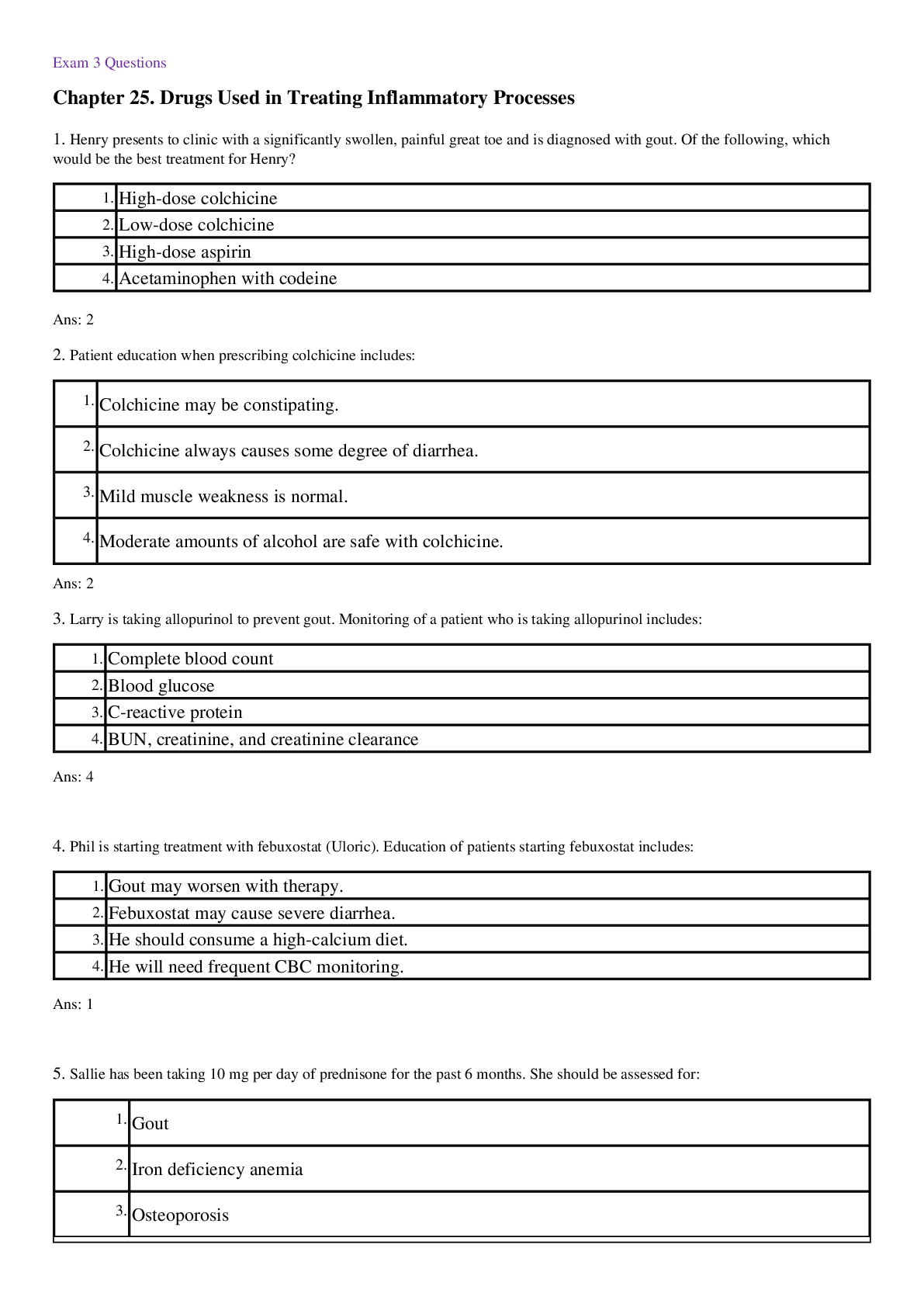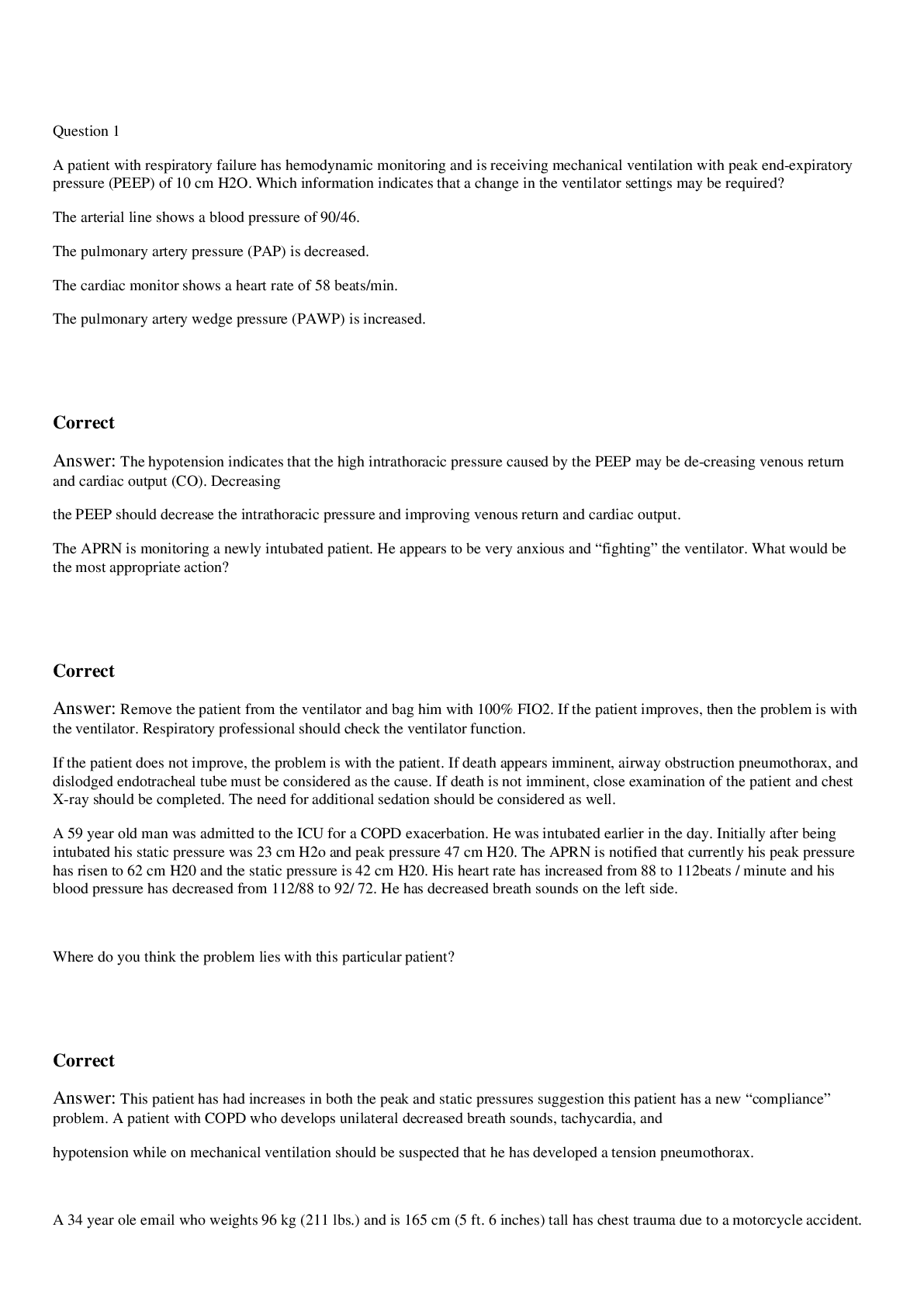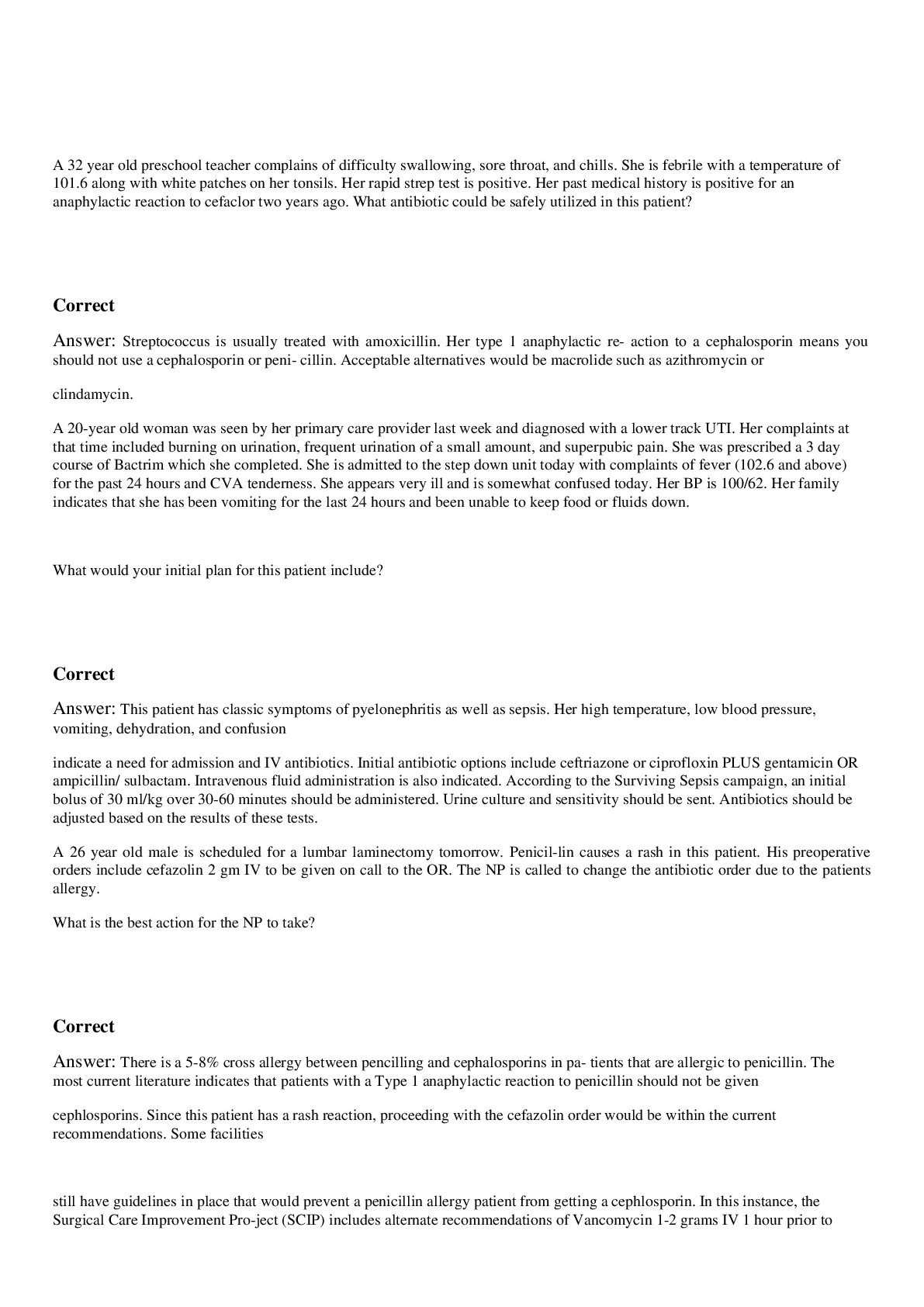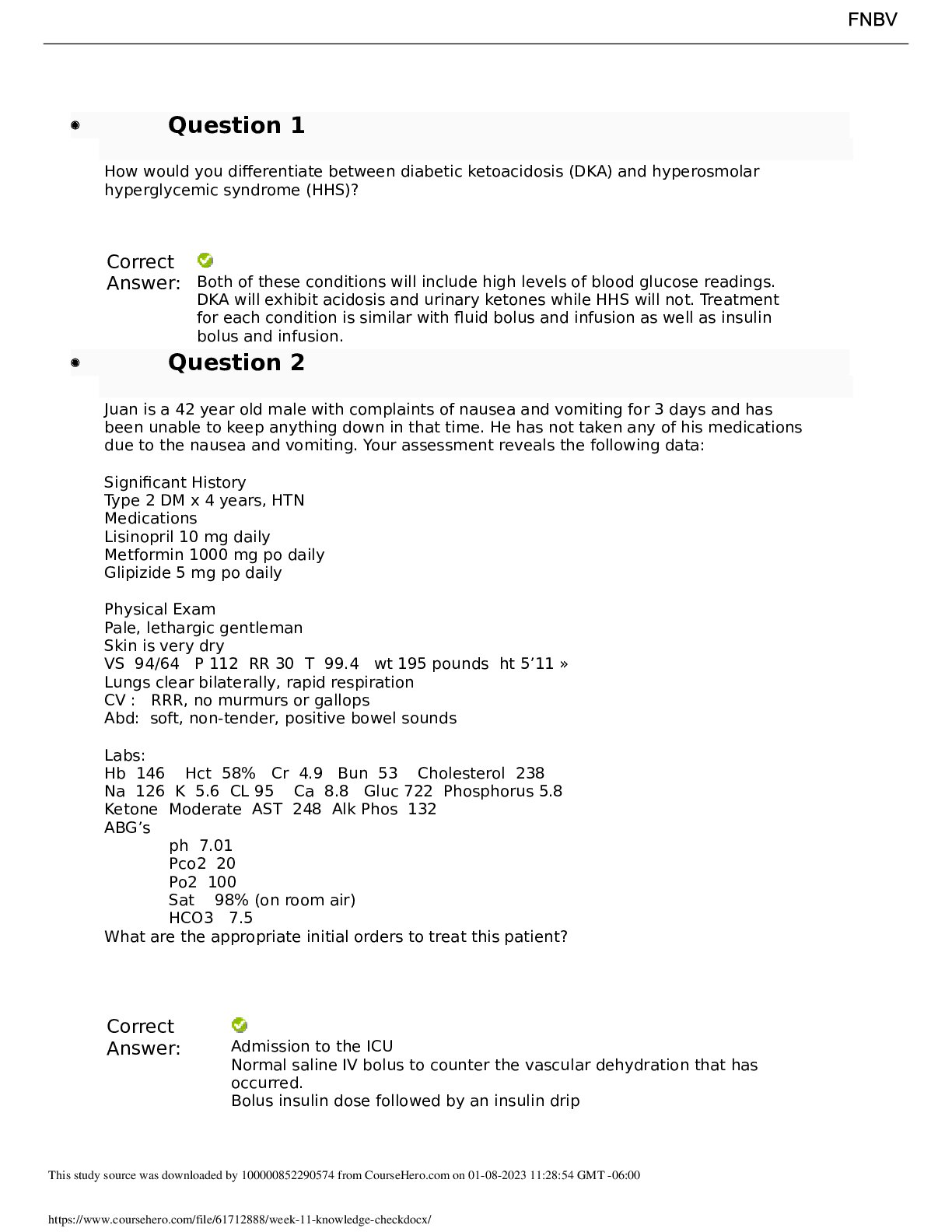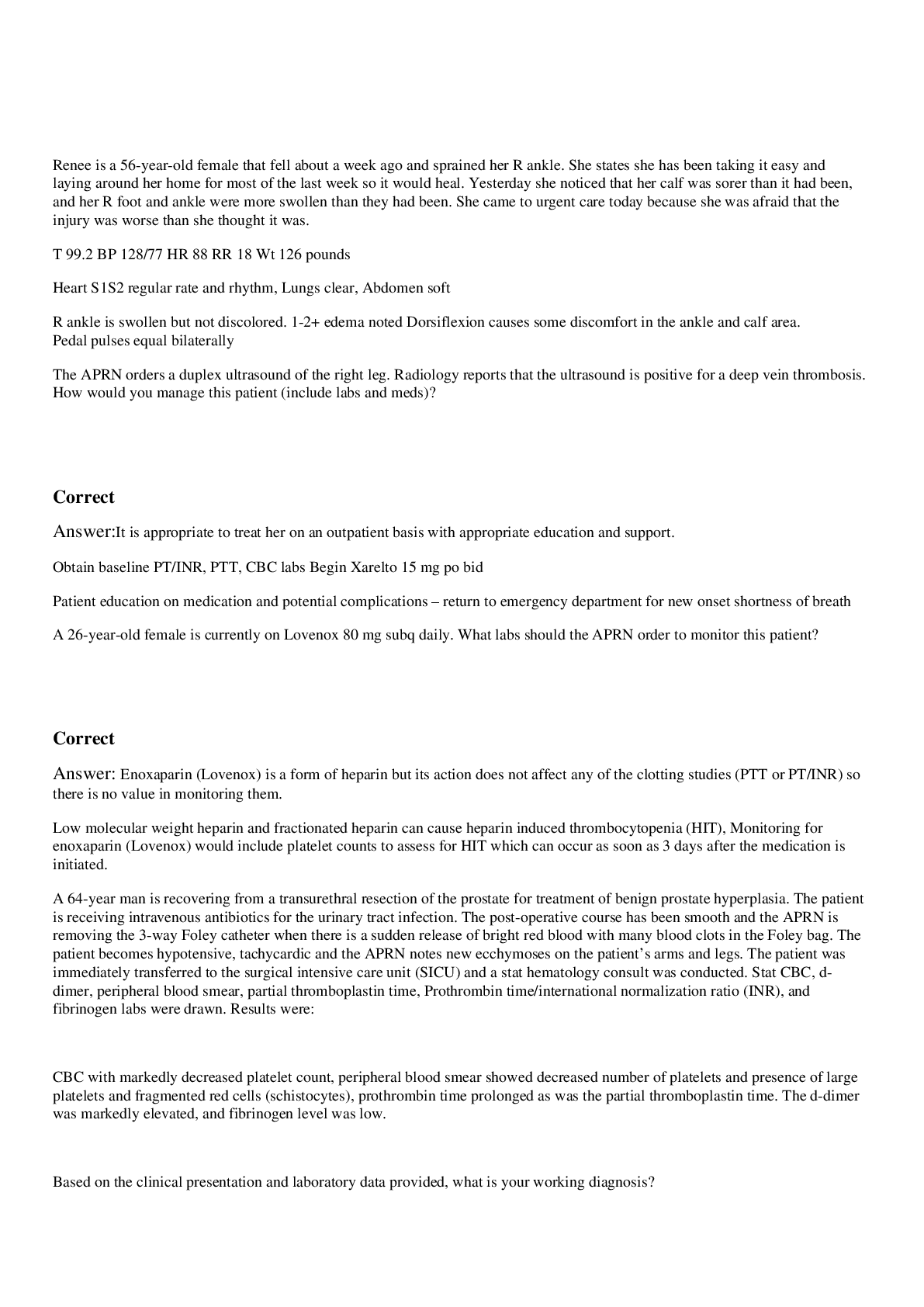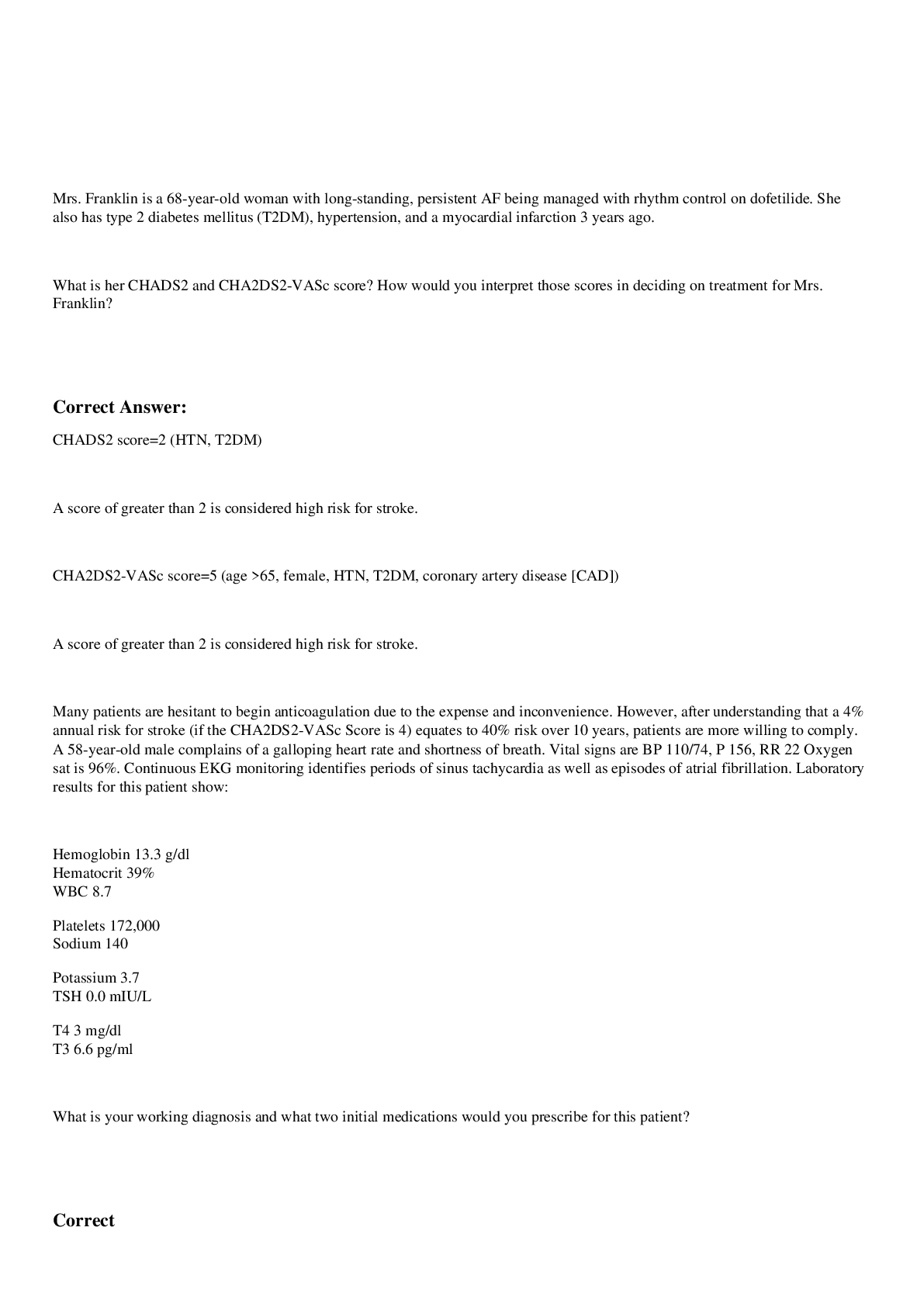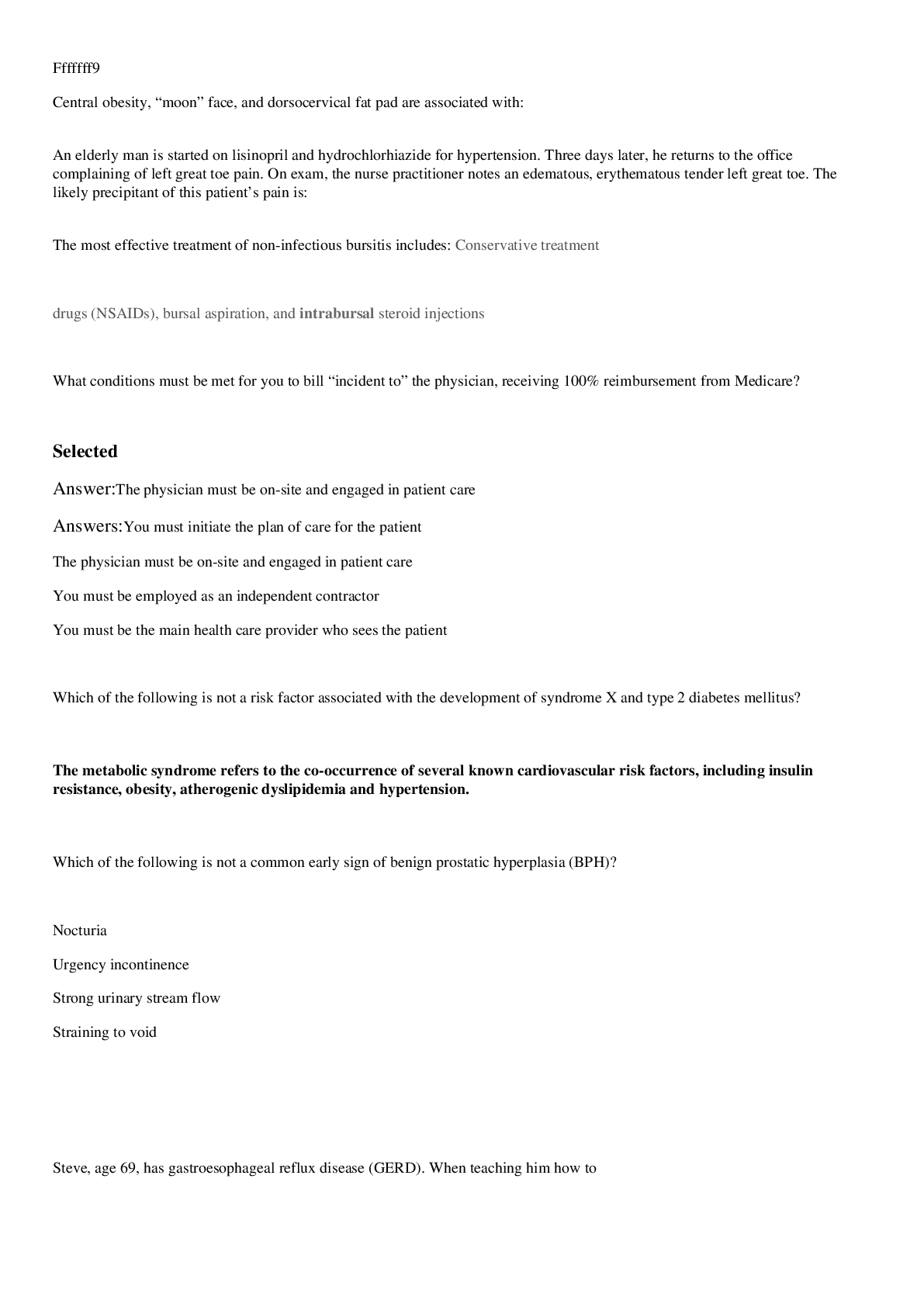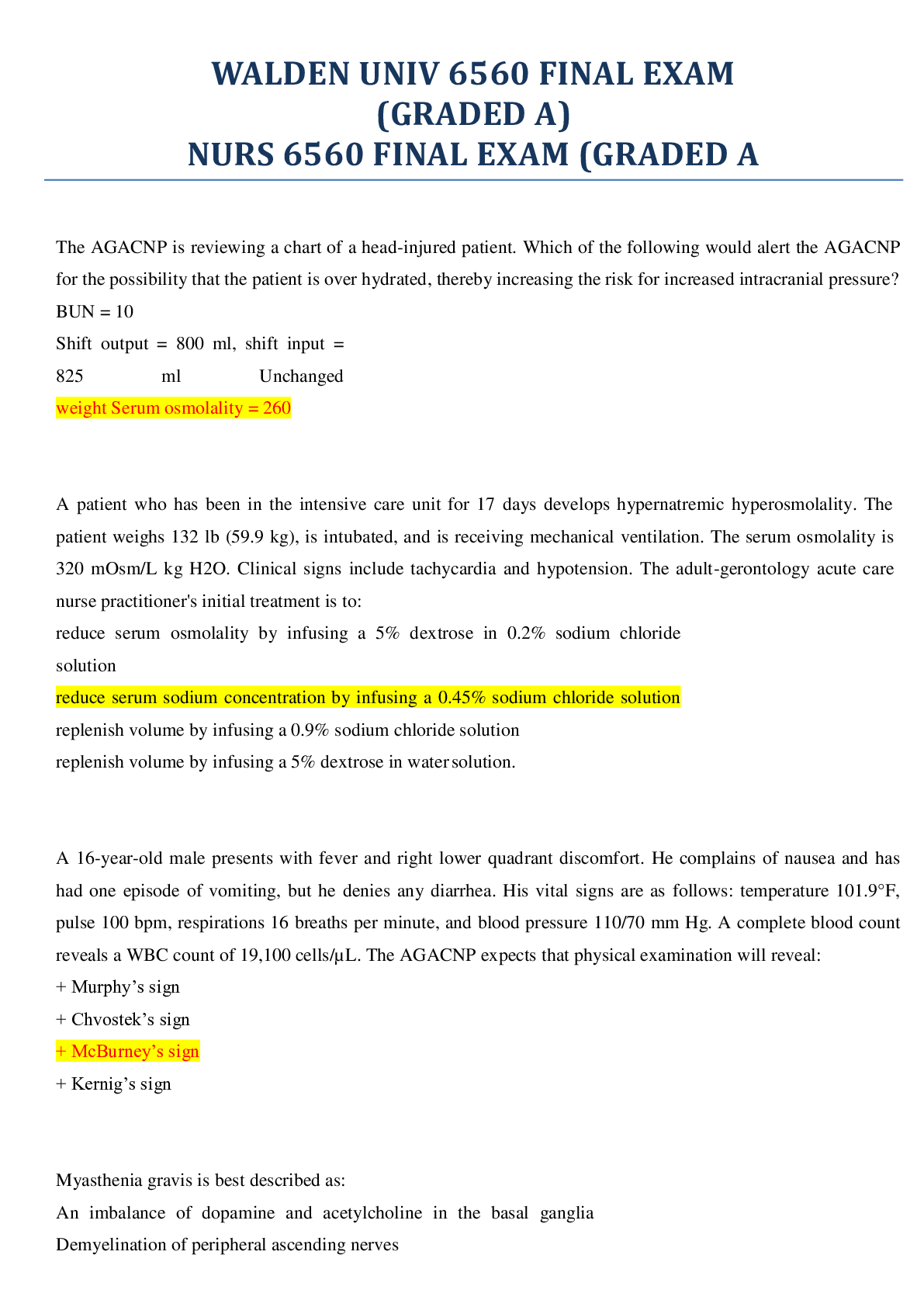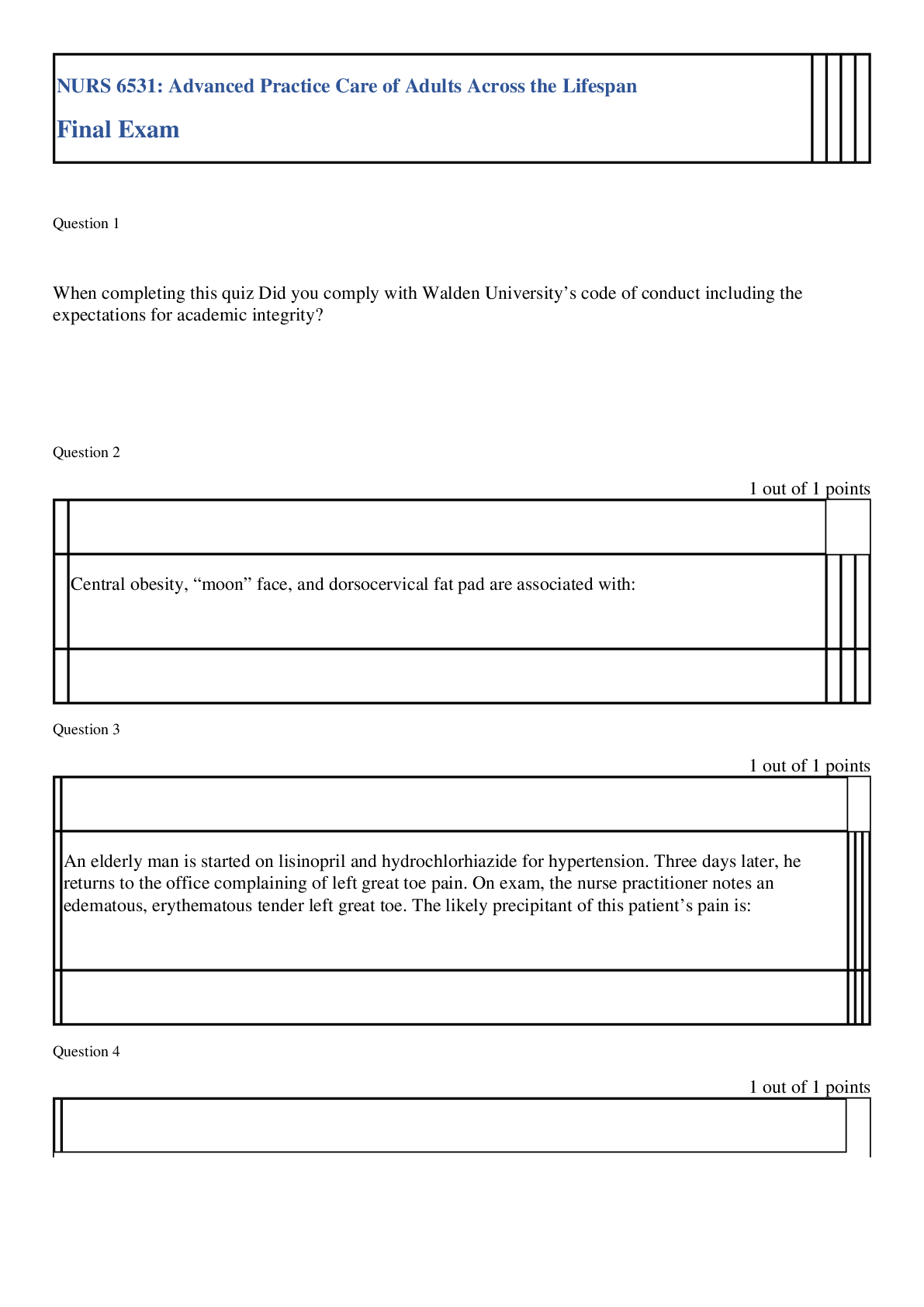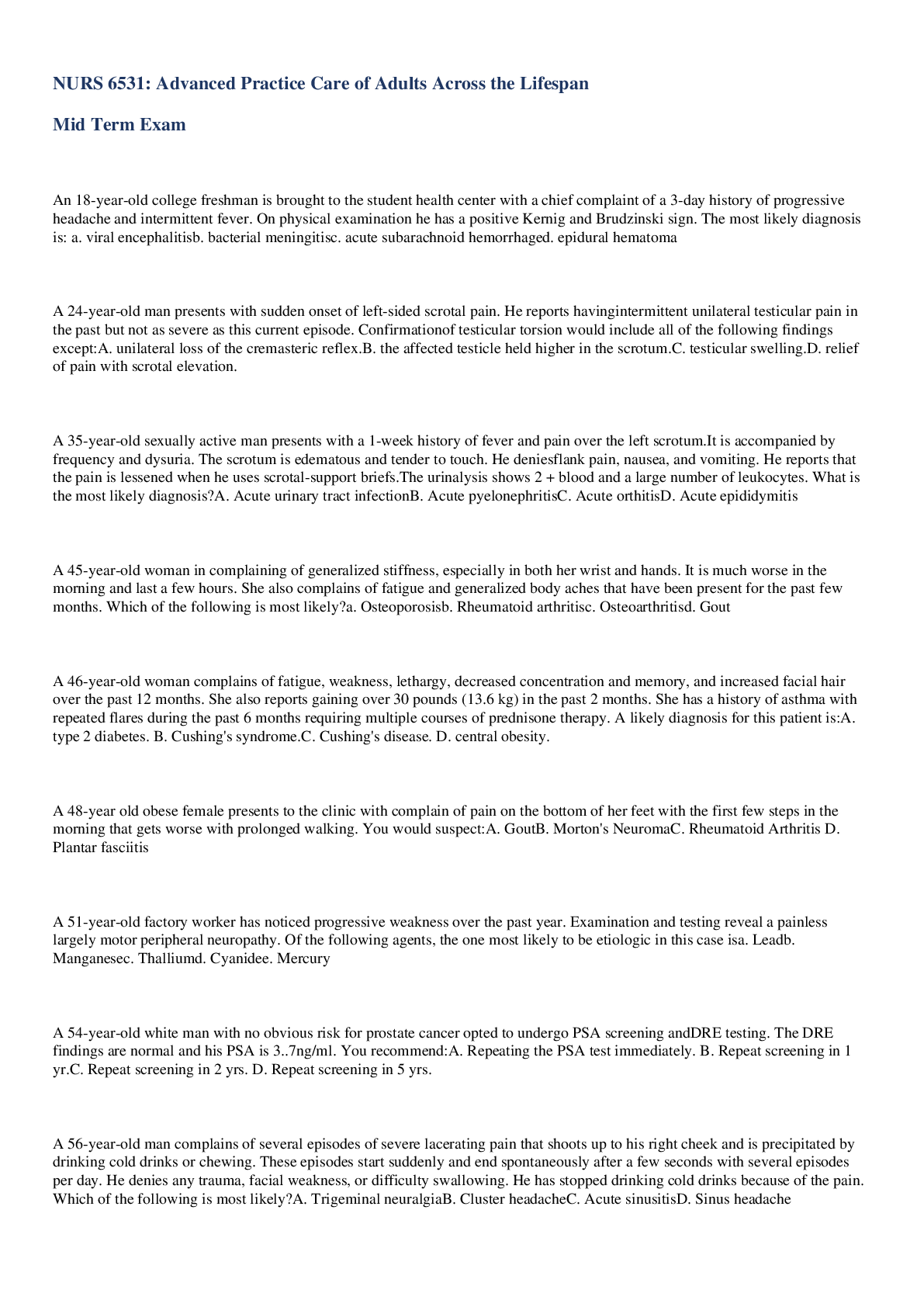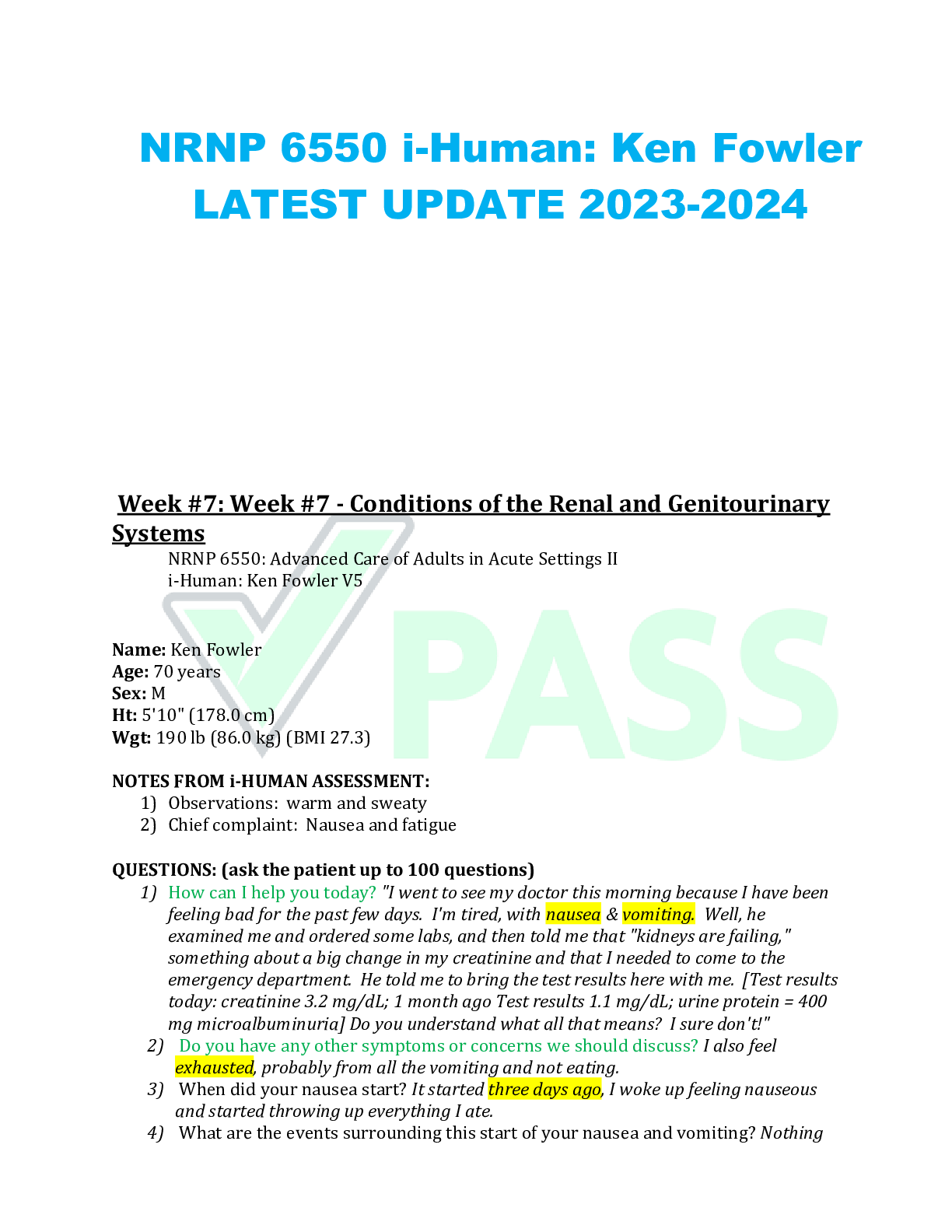NURS-6531N-8,Adv. Practice Care of Adults
Document Content and Description Below
User Course NURS-6531N-8,Adv. Practice Care of Adults.2018 Summer Qtr 05/29- 08/19-PT27 Test Midterm Exam Status Needs Grading Attempt Score 100 out of 100 points Time Elapsed 1 hour, 53 minute... s out of 1 hour and 50 minutesOVER TIME Results Displayed All Answers, Submitted Answers, Correct Answers Question 1 0 out of 0 points When completing this quiz, did you comply with Walden University’s Code of Conduct including the expectations for academic integrity? Selected Answer: Yes Answers: Yes No Question 2 1 out of 1 points The most common cancer found on the auricle is: Selected Answer: Basal cell carcinoma Answers: Actinic keratosis Basal cell carcinoma Squamous cell carcinoma Acral-lentiginous melanoma Question 3 0 out of 1 points Which of the following medication classes should be avoided in patients with acute or chronic bronchitis because it will contribute to ventilation-perfusion mismatch in the patient? Selected Answer: Anticholinergics Answers: XanthinesAntihistimines Steroids Anticholinergics Question 4 1 out of 1 points A 47 year old male patient presents to the clinic with a single episode of a moderate amount of bright red rectal bleeding. On examination, external hemorrhoids are noted. How should the nurse practitioner proceed? Selected Answer: Instruct the patient on measures to prevent hemorrhoids such as bowel habits and diet. Answers: Instruct the patient on measures to prevent hemorrhoids such as bowel habits and diet. Order a topical hemorrhoid cream along with a stool softener. Refer the patient for a barium enema and sigmoidoscopy. Refer the patient for a surgical hemorrhoidectomy. Question 5 1 out of 1 points Which of the following patient characteristics are associated with chronic bronchitis? Selected Answer: Underweight, pink skin, and increased respiratory rate Answers: Overweight, cyanosis, and normal or slightly increased respiratory rate Underweight, pink skin, and increased respiratory rate Overweight, pink skin, and normal or slightly increased respiratory rate Normal weight, cyanosis, and greatly increased respiratory rate Question 6 1 out of 1 points A 65-year-old female with a past medical history of hypertension, hyperlipidemia, and polymyalgia rheumatica presents to urgent care with new onset left lower quadrant pain. Her current medications include omeprazole 20 milligrams po daily, lisinopril 20 milligrams po daily, simvastatin 20 milligrams po daily, and prednisone 12 milligrams po daily. The nurse practitioner suspects acute diverticulitis and possibly an abscess. The most appropriate diagnostic test for this patient at this time is:Selected Answer: CT scan Answers: CBC/diff Erythrocyte sedimentation rate Abdominal ultrasound CT scan Question 7 1 out of 1 points A patient reports “something flew in my eye” about an hour ago while he was splitting logs. If there were a foreign body in his eye, the nurse practitioner would expect to find all except: Selected Answer: Purulent drainage Answers: Purulent drainage Tearing Photophobia A positive fluorescein stain Question 8 1 out of 1 points A 21 year old college student presents to the student health center with copious, markedly purulent discharge from her left eye. The nurse practitioner student should suspect: Selected Answer: Gonococcal conjunctivitis Answers: Viral conjunctivitis Common pink eye Gonococcal conjunctivitis Allergic conjunctivitis Question 9 0 out of 1 points A 35 year old man presents with radicular pain followed by the appearance of grouped vesicles consisting of about 15 lesions across 3 different thoracic dermatomes. He complains of pain, burning, and itching. The nurse practitioner should suspect: Selected Answer: A complicated case of shingles and prescribe acyclovir, an analgesic, and a topical cortisone cream Answers: A common case of shingles and prescribe an analgesic and an antiviral agent A complicated case of shingles and prescribe acyclovir, an analgesic, and a topical cortisone cream Herpes zoster and consider that this patient may be immunocompromised A recurrence of chickenpox and treat the patient’s symptoms Question 10 0 out of 1 points Which type of lung cancer has the poorest prognosis? Selected Answer: Adenocarcinoma Answers: Adenocarcinoma Epidermoid carcinoma Small cell carcinoma Large cell carcinoma Question 11 1 out of 1 points An 83-year-old female presents to the office complaining of diarrhea for several days. She explains she has even had fecal incontinence one time. She describes loose stools 3–4 times a day for several weeks and denies fever, chills, pain, recent antibiotic use. The history suggests that the patient has: Selected Answer: Chronic diarrheaAnswers: Acute diarrhea Chronic diarrhea Irritable bowel Functional bowel disease Question 12 1 out of 1 points Margaret, age 32, comes into the office with painful joints and a distinctive rash in a butterfly distribution on her face. The rash has red papules and plaques with a fine scale. What do you suspect? Selected Answer: Systemic lupus erythematosus Answers: An allergic reaction Relapsing polychondritis Lymphocytoma cutis Systemic lupus erythematosus Question 13 1 out of 1 points Antibiotic administration has been demonstrated to be of little benefit to the treatment of which of the following disease processes? Selected Answer: Acute bronchitis Answers: Chronic sinusitis Acute bronchitis Bacterial pneumonia Acute exacerbation of chronic bronchitis Question 14 0 out of 1 pointsLisa, age 49, has daily symptoms of asthma. She uses her inhaled short-acting beta-2 agonist daily. Her exacerbations affect her activities and they occur at least twice weekly and may last for days. She is affected more than once weekly during the night with an exacerbation. Which category of asthma severity is Lisa in? Selected Answer: Mild persistent Answers: Mild intermittent Mild persistent Moderate persistent Question 15 0 out of 1 points Which of the following is the most appropriate therapeutic regimen for an adult patient with no known allergies diagnosed with group A B-hemolytic strep? Selected Answer: None of the above Answers: Penicillin V 500 milligrams PO every 8 hours for 10 days Ampicillin 250 milligrams PO twice a day for 10 days Clarithromycin 500 milligrams po daily for 7 days None of the above Question 16 0 out of 1 points A cashier complains of dull ache and pressure sensation in her lower legs. It is relieved by leg elevation. She occasionally has edema in her lower legs at the end of the day. What is the most likely cause of these problems? Selected Answer: Arterial insufficiency Answers: Congestive heart failure Varicose veins Deep vein thrombosis Arterial insufficiency Question 171 out of 1 points Which statement below is correct about pertussis? Selected Answer: It is also called whooping cough Answers: It is also called whooping cough It begins with symptoms like strep throat It lasts about 3 weeks It occurs most commonly in toddlers and young children Question 18 0 out of 1 points Which of the following is the most important diagnosis to rule out in the adult patient with acute bronchitis? Selected Answer: Asthma Answers: Pneumonia Asthma Sinusitis Pertussis Question 19 1 out of 1 points A 70 year old patient presents with left lower quadrant (LLQ) abdominal pain, a markedly tender palpable abdominal wall, fever, and leukocytosis. Of the following terms, which correctly describes the suspected condition? Selected Answer: Diverticulitis Answers: Diverticulosis DiverticulaDiverticulitis Diverticulum Question 20 1 out of 1 points Sylvia, age 83, presents with a 3 day history of pain and burning in the left forehead. This morning she noticed a rash with erythematous papules in that site. What do you suspect? Selected Answer: Herpes zoster Answers: Varicella Herpes zoster Syphilis Rubella Question 21 0 out of 1 points A 33-year-old female is admitted with acute pancreatitis. The nurse practitioner knows that the most common cause of pancreatitis is: Selected Answer: Medications Answers: Alcohol Gallstones Medications Pregnancy Question 22 1 out of 1 points When a patient presents with symptoms of acute gallbladder disease, what is the appropriate nurse practitioner action? Selected Answer: Order an abdominal ultrasound Answers: Order abdominal x-raysOrder an abdominal ultrasound Refer the patient to a surgeon for evaluation Prescribe pain medication Question 23 0 out of 1 points A false-positive result with the fecal occult blood test can result from: Selected Answer: stool that has been stored before testing Answers: ingestion of large amounts of vitamin C a high dietary intake of rare cooked beef a colonic neoplasm that is not bleeding stool that has been stored before testing Question 24 0 out of 1 points A 76-year-old male complains of weight loss, nausea, vomiting, abdominal cramping and pain. Physical findings include an abdominal mass and stool positive for occult blood. The nurse practitioner pain suspects a tumor in the small intestine. The best diagnostic test for this patient is: Selected Answer: Colonoscopy Answers: Colonoscopy Small bowel follow-through Barium enema CT abdomen Question 25 1 out of 1 points A patient presents to urgent care complaining of dyspnea, fatigue, and lower extremity edema. The echocardiogram reveals and ejection fraction of 38%. The nurse practitioner knows that these findings are consistent with: Selected Answer: Systolic heart failure Answers: Mitral regurgitation Systolic heart failure Cardiac myxoma Diastolic heart failure Question 26 1 out of 1 points Maxine, Age 76, has just been given a diagnosis of pneumonia. Which of the following is an indication that she should be hospitalized? Selected Answer: Multilobar involvement on chest x-ray with the inability to take oral medications Answers: Multilobar involvement on chest x-ray with the inability to take oral medications Alert and oriented, slightly high but stable vital signs, and no one to take care of her at home Sputum and gram positive organisms A complete blood count showing leukocytosis Question 27 0 out of 1 points A 55 year old man is diagnosed with basal cell carcinoma. The nurse practitioner correctly tells him: Selected Answer: “It is the most common cause of death in patients with skin cancer.” Answers: “It is the most common cause of death in patients with skin cancer.” “It can be cured with surgical excision or radiation therapy.”“It is a slow growing skin cancer that rarely undergoes malignant changes.” “It can be cured using 5-flurouracil cream twice daily for 2 to 4 weeks.” Question 28 1 out of 1 points Expected spirometry readings when the patient has chronic emphysema include: Selected Answer: Increased total lung capacity (TLC) Answers: Decreased residual volume (RV) Increased vital capacity (VC) Increased forced expiratory volume (FEV-1) Increased total lung capacity (TLC) Question 29 1 out of 1 points An 80-year-old male admits to difficulty swallowing during the review of systems. The nurse practitioner recognizes the differential diagnosis for this patient’s dysphagia is: Selected Answer: A and C Answers: Esophageal cancer Chest pain GERD A and C All of the above Question 30 0 out of 1 points A 40 year old female with history of frequent sun exposure presents with a multicolored lesion on her back. It has irregular borders and is about 11mm in diameter. What should the nurse practitioner suspect? Selected Answer:Basal cell carcinoma Answers: Squamous cell carcinoma Malignant melanoma A common nevus Basal cell carcinoma Question 31 1 out of 1 points Which of the following is not a goal of treatment for the patient with cystic fibrosis? Selected Answer: Replace water-soluble vitamins Answers: Prevent intestinal obstruction Provide adequate nutrition Promote clearance of secretions Replace water-soluble vitamins Question 32 1 out of 1 points The nurse practitioner is performing a physical exam on a middle-aged African-American man. Which of the following areas is a common site for melanomas in African-Americans and other dark-skinned individuals? Selected Answer: B and C Answers: Scalp Nails Feet B and C All of the above Question 33 1 out of 1 points An adult presents with tinea corporis. Which item below is a risk factor for its development? Selected Answer: Topical steroid use Answers: Topical steroid use Topical antibiotic use A recent laceration Cold climates Question 34 0 out of 1 points A patient has experienced nausea and vomiting, headache, malaise, low grade fever, abdominal cramps, and watery diarrhea for 72 hours. His white count is elevated with a shift to the left. He is requesting medication for diarrhea. What is the most appropriate response? Selected Answer: Order stool cultures. Answers: Prescribe loperamide (Immodium) or atropine-diphenoxylate (Lomotil) and a clear liquid diet for 24 hours. Prescribe a broad-spectrum antibiotic such as ciprofloxacin (Cipro), and symptom management. Offer an anti-emetic medication such as ondansetron (Zofran) and provide oral fluid and electrolyte replacement instruction. Order stool cultures. Question 35 1 out of 1 points Janine, age 29, has numerous transient lesions that come and go, and she is diagnosed with urticaria. What do you order? Selected Answer: Antihistamines Answers: AspirinNSAIDs Opioids Antihistamines Question 36 0 out of 1 points Of the following signs and symptoms of congestive heart failure (CHF), the earliest clinical manifestation is: Selected Answer: Peripheral edema Answers: Peripheral edema Weight gain Shortness of breath Nocturnal dyspnea Question 37 1 out of 1 points A 16 year old male presents with mild sore throat, fever, fatigue, posterior cervical adenopathy, and palatine petechiae. Without a definitive diagnosis for this patient, what drug would be least appropriate to prescribe? Selected Answer: Amoxicillin Answers: Ibuprofen Erythromycin Amoxicillin Acetaminophen Question 38 1 out of 1 points A 70 year old man who walks 2 miles every day complains of pain in his left calf when he is walking. The problem has gotten gradually worse and now he is unable to complete his 2 mile walk. What question asked during the history, if answered affirmatively, would suggest a diagnosis of arteriosclerosis obliterans? Selected Answer: “Is your leg pain relieved by rest?”Answers: “Are you wearing your usual shoes?” “Do you also have chest pain when you have leg pain?” “Is your leg pain relieved by rest?” “Do you ever have the same pain in the other leg?” Question 39 0 out of 1 points Which of the following statements about malignant melanomas is true? Selected Answer: They usually occur in older adult males Answers: They usually occur in older adult males The patient has no family history of melanoma They are common in blacks The prognosis is directly related to the thickness of the lesion Question 40 1 out of 1 points Sheila, age 78, presents with a chief complaint of waking up during the night coughing. You examine her and find an S3 heart sound, pulmonary crackles that do not clear with coughing, and peripheral edema. What do you suspect? Selected Answer: Heart failure Answers: Asthma Nocturnal allergies Valvular disease Heart failure Question 41 0 out of 1 points Which antibiotic would be the most effective in treating community acquired pneumonia (CAP) in a young adult without any comorbid conditions?Selected Answer: Doxycycline (Vibramycin) Answers: Erythromycin Clarithromycin (Biaxin) Doxycycline (Vibramycin) Penicillin Question 42 1 out of 1 points Which of the following dermatologic vehicles are the most effective in absorbing moisture and decreasing friction? Selected Answer: Powders Answers: Powders Gels Creams Lotion Question 43 1 out of 1 points A 70 year old patient presents with a slightly raised, scaly, erythematous patch on her forehead. She admits to having been a “sun worshiper.” The nurse practitioner suspects actinic keratosis. This lesion is a precursor to: Selected Answer: Squamous cell carcinoma Answers: Squamous cell carcinoma Basal cell carcinoma Malignant melanomaAcne vulgaris Question 44 1 out of 1 points An elderly patient is being seen in the clinic for complaint of “weak spells” relieved by sitting or lying down. How should the nurse practitioner proceed with the physical examination? Selected Answer: Compare the patient’s blood pressure lying first, then sitting, and then standing. Answers: Assist the patient to a standing position and take her blood pressure. Assess the patient’s cranial nerves. Compare the patient’s blood pressure lying first, then sitting, and then standing. Compare the amplitude of the patient’s radial and pedal pulses. Question 45 1 out of 1 points What oral medication might be used to treat chronic cholethiasis in a patient who is a poor candidate for surgery? Selected Answer: Ursodiol Answers: Ursodiol Ibuprofen Prednisone Surgery is the only answer Question 46 0 out of 1 points A 46-year-old female with a past medical history of diabetes presents with a swollen, erythematous right auricle and is diagnosed with malignant otitis externa. The nurse practitioner knows that the most likely causative organism for this patient’s problem is: Selected Answer: Staphylococcus aureusAnswers: Staphylococcus aureus Group A beta hemolytic streptococcus Haemophilus influenza Pseudomonas aeruginosa Question 47 0 out of 1 points Which of the following is not a symptom of irritable bowel syndrome? Selected Answer: Painful diarrhea Answers: Painful diarrhea Painful constipation Cramping and abdominal pain Weight loss Question 48 1 out of 1 points A patient comes in complaining of 1 week of pain in the posterior neck with difficulty turning the head to the right. What additional history is needed? Selected Answer: Any recent trauma Answers: Any recent trauma Difficulty swallowing Stiffness in the right shoulder Change in sleeping habits Question 49 0 out of 1 points Marvin, age 56, is a smoker with diabetes. He has just been diagnosed as hypertensive. Which of the following drugs has the potential to cause the development of bronchial asthma and inhibit gluconeogenesis? Selected Answer: ACE InhibitorAnswers: ACE Inhibitor Beta Blocker Calcium channel blocker Diuretic Question 50 1 out of 1 points The differential diagnosis for a patient complaining of a sore throat includes which of the following? Selected Answer: A, B, and C Answers: Gonococcal infection Thrush Leukoplakia B only A, B, and C Question 51 0 out of 1 points A patient presents to the primary care provider complaining of a rash on his right forehead that started yesterday and is burning and painful. The physical exam reveals an erythematous, maculopapular rash that extends over the patient’s right eye to his upper right forehead. Based on the history and examination, the most likely cause of this patient’s symptoms is: Selected Answer: Rhus dermatitis Answers: Rhus dermatitis Ophthalmic zoster Chemosis Optic neuritis Question 52 0 out of 1 points Before initiating an HMG CoA-reductase inhibitor for hyperlipidemia, the nurse practitioner orders liver function studies. The patient’s aminotransferase (ALT) is elevated. What laboratory test(s) should be ordered? Selected Answer: Serum cholesterol with HDL and LDL Answers: Serologic markers for hepatitis Serum bilirubin Serum cholesterol with HDL and LDL A liver biopsy Question 53 1 out of 1 points A patient with elevated lipids has been started on lovastatin. After 3 weeks of therapy, he calls to report generalized muscle aches. The nurse practitioner should suspect: Selected Answer: Rhabdomyolysis Answers: A drug interaction Hepatic dysfunction Hypersensitivity to lovastatin Rhabdomyolysis Question 54 1 out of 1 points Treatment of acute vertigo includes: Selected Answer: Bedrest and an antihistamine Answers: Bedrest and an antihistamine Fluids and a decongestantA sedative and decongestant Rest and a low sodium diet Question 55 1 out of 1 points Treatment of H.pylori includes which of the following? Selected Answer: A, B, and C Answers: Proton pump inhibitor Antibiotic therapy Bismuth subsalicylate A and B A, B, and C Question 56 1 out of 1 points Carl, age 78, is brought to the office by his son, who states that his father has been unable to see clearly since last night. Carl reports that his vision is “like looking through a veil.” He also sees floaters and flashing lights but is not having any pain. What do you suspect? Selected Answer: Retinal detachment Answers: Cataracts Glaucoma Retinal detachment Iritis Question 57 1 out of 1 points In order to decrease deaths from lung cancer: Selected Answer:Patients should be counseled to quit smoking Answers: All smokers should be screened annually All patients should be screened annually Only high risk patients should be screened routinely Patients should be counseled to quit smoking Question 58 1 out of 1 points John, age 33, has a total cholesterol level of 188 mg/dL. How often should he be screened for hypercholesterolemia? Selected Answer: Every 5 years Answers: Every 5 years Every 2 years Every year Whenever blood work is done Question 59 1 out of 1 points Mort is hypertensive. Which of the following factors influenced your choice of using an alpha blocker as the antihypertensive medication? Selected Answer: Mort has benign prostatic hyperplasia Answers: Mort is black Mort also has congestive heart failure Mort has benign prostatic hyperplasia Mort has frequent migraine headaches Question 60 1 out of 1 points John, age 59, presents with recurrent, sharply circumscribed red papules and plaques with a powdery white scale on the extensor aspect of his elbows and knees. What do you suspect? Selected Answer: Psoriasis Answers: Actinic keratosis Eczema Psoriasis Seborrheic dermatitis Question 61 1 out of 1 points Harriet, a 79-year-old woman, comes to your office every 3 months for follow up on her hypertension. Her medications include one baby aspirin daily, Lisinopril 5mg daily, and Calcium 1500 mg daily. At today’s visit. Her blood pressure is 170/89. According to JNC VIII guidelines, what should you do next to control Harriet’s blood pressure? Selected Answer: Add a thiazide diuretic to the Lisinopril 5mg daily Answers: Increase her Lisinopril to 20mg daily Add a thiazide diuretic to the Lisinopril 5mg daily Discontinue the Lisinopril and start a combination of ACE Inhibitor and calcium channel blocker Discontinue the Lisinopril and start a diuretic Question 62 0 out of 1 points An active 65-year-old man under your care has known acquired valvular aortic stenosis and mitral regurgitation. He also has a history of infectious endocarditis. He has recently been told he needs elective replacement of his aortic valve. When he comes into the office you discover that he has 10 remaining teeth in poor repair. Your recommendation would be to: Selected Answer: coordinate with his cardiac and oral surgeons to have the tooth extractions and valve replacement done at the same time to reduce the risk of anesthetic complications. Answers: defer any further dental work until his valve replacement is completedinstruct him to have dental extraction done cautiously, having no more than 2 teeth per visit removed. suggest he consult with his oral surgeon about having all the teeth removed at once and receiving appropriate antibiotic prophylaxis coordinate with his cardiac and oral surgeons to have the tooth extractions and valve replacement done at the same time to reduce the risk of anesthetic complications. Question 63 0 out of 1 points Appropriate therapy for peptic ulcer disease (PUD) is: Selected Answer: Dependent on cessation of NSAID use Answers: Primarily by eradication of infection Based on etiology Aimed at diminishing prostaglandin synthesis Dependent on cessation of NSAID use Question 64 1 out of 1 points Shirley, age 58, has been a diabetic for 7 years. Her blood pressure is normal. Other than her diabetes medications, what would you prescribe today during her routine office visit? Selected Answer: An ACE Inhibitor Answers: A calcium channel blocker A beta blocker An ACE Inhibitor No hypertension medication Question 65 1 out of 1 points Medicare is a federal program administered by the Centers for Medicare and Medicaid Services (CMS). The CMS has developed guidelines for Evaluation and Management coding, which all providers are expected to follow when coding patient visits for reimbursement. Which of the following is an important consideration regarding billing practices? Selected Answer: Failing to bill for billable services will lead to unnecessarily low revenues Answers: It is important to “undercode” so that one does not get charged with Medicare fraud The practice of “overcoding” is essential in this age of decreasing reimbursements Failing to bill for billable services will lead to unnecessarily low revenues Time spent with the patient is a very important determinant of billing Question 66 1 out of 1 points A 2 year old presents with a white pupillary reflex. What is the most likely cause of this finding? Selected Answer: Retinoblastoma Answers: Viral conjunctivitis Glaucoma Corneal abrasion Retinoblastoma Question 67 0 out of 1 points Harvey has had Meniere’s disease for several years. He has some hearing loss but now has persistent vertigo. What treatment might be instituted to relieve the vertigo? Selected Answer: A labyrinthectomy Answers: Pharmacological therapy A labyrinthectomy A vestibular neurectomy Wearing an earplug in the ear with the most hearing loss Question 68 0 out of 1 pointsWhich of the following is not a risk factor for coronary arterial insufficiency? Selected Answer: Hyperhomocysteinemia Answers: Hyperhomocysteinemia Smoking Genetic factors Alcohol ingestion Question 69 1 out of 1 points An 18-year-old female presents to the urgent care center complaining of severe pruritus in both eyes that started 2 days ago. Associated symptoms include a headache and fatigue. On examination, the nurse practitioner notes some clear discharge from both eyes and some erythema of the eyelids and surrounding skin. Which of the following is the most likely cause of this patient’s symptoms? Selected Answer: Allergic conjunctivitis Answers: Allergic conjunctivitis Bacterial conjunctivitis Gonococcal conjunctivitis Viral conjunctivitis Question 70 0 out of 1 points A 20 year old is diagnosed with mild persistent asthma. What drug combination would be most effective in keeping him symptom-free? Selected Answer: A long-acting bronchodilator Answers: A long-acting bronchodilator An inhaled corticosteroid and cromolyn Theophylline and a short acting bronchodilatorA bronchodilator PRN and an inhaled corticosteroid Question 71 0 out of 1 points Acute rheumatic fever is an inflammatory disease which can follow infection with: Selected Answer: Β-hemolytic Streptococcus Answers: Group A Streptococcus Staphlococcus areus Β-hemolytic Streptococcus Streptococcus pyogenes Question 72 0 out of 1 points A 60 year old male diabetic patient presents with redness, tenderness, and edema of the left lateral aspect of his face. His left eyelid is grossly edematous. He reports history of a toothache in the past week which “is better.” His temperature is 100°F and pulse is 102 bpm. The most appropriate initial action is to: Selected Answer: Start an oral antibiotic, mouth swishes with an oral anti-infective, and an analgesic Answers: Start an oral antibiotic, refer the patient to a dentist immediately, and follow up within 3 days Order mandibular x-rays and question the patient about physical abuse Start an oral antibiotic, mouth swishes with an oral anti-infective, and an analgesic Initiate a parenteral antibiotic and consider hospital admission Question 73 1 out of 1 points If a patient presents with a deep aching, red eye and there is no discharge, you should suspect: Selected Answer:Iritis Answers: Iritis Allergic conjunctivitis Viral conjunctivitis Bacterial conjunctivitis Question 74 1 out of 1 points The National Cholesterol Education Program’s Adult Treatment Panel III recommends that the goal for low density lipoproteins in high risk patients be less than: Selected Answer: 100 mg/dL Answers: 160 mg/dL 130 mg/dL 100 mg/dL 70 mg/dL Question 75 1 out of 1 points A patient presents with classic symptoms of gastroesophageal reflux disease (GERD). He is instructed on life style modifications and drug therapy for 8 weeks. Three months later he returns, reporting that he was “fine” as long as he took the medication. The most appropriate next step is: Selected Answer: Investigation with endoscopy, manometry, and/or pH testing Answers: Referral for surgical intervention such as a partial or complete fundoplication Dependent upon how sever the practitioner believes the condition To repeat the 8 week course of drug therapy while continuing lifestyle modifications Investigation with endoscopy, manometry, and/or pH testing Question 76 0 out of 1 points Group A β-hemolytic streptococcal (GABHS) pharyngitis is most common in which age group? Selected Answer: Under 3 years of age Answers: Under 3 years of age Preschool children 6 to 12 years of age Adolescents Question 77 0 out of 1 points The most appropriate treatment for a child with mild croup is: Selected Answer: A decongestant Answers: A bronchodilator An antibiotic A decongestant A cool mist vaporizer Question 78 0 out of 1 points A child complains that his “throat hurts” with swallowing. His voice is very “throaty” and he is hyperextending his neck to talk. Examination reveals asymmetrical swelling of his tonsils. His uvula is deviated to the left. What is the most likely diagnosis? Selected Answer: Epiglottitis Answers: Peritonsillar abscess ThyroiditisMononucleosis Epiglottitis Question 79 1 out of 1 points Salmeterol (Servent) is prescribed for a patient with asthma. What is the most important teaching point about this medication? Selected Answer: It is not effective during an acute asthma attack. Answers: It is not effective during an acute asthma attack. It may take 2 to 3 days to begin working. This drug works within 10 minutes. This drug may be used by patients 6 years and older. Question 80 0 out of 1 points Which intervention listed below is safe for long term use by an adult with constipation? Selected Answer: Stool softeners Answers: Bulk-forming agents Stool softeners Laxatives Osmotic agents Question 81 1 out of 1 points A 40 year old presents with a hordeolum. The nurse practitioner teaches the patient to: Selected Answer: Apply a topical antibiotic and warm compresses.Answers: Apply a topical antibiotic and warm compresses. Apply cool compresses and avoid touching the hordeolum. Use an oral antibiotic and eye flushes. Apply light palpation to facilitate drainage. Question 82 1 out of 1 points Sarah has allergic rhinitis and is currently being bothered by nasal congestion. Which of the following meds ordered for allergic rhinitis would be most appropriate? Selected Answer: A decongestant nasal spray Answers: An antihistamine intranasal spray A decongestant nasal spray Ipratropium Omalizumab Question 83 1 out of 1 points What is the Gold standard for the diagnosis of asthma? Selected Answer: Spirometry Answers: Patient’s perception of clogged airways Validated quality-of-life questionnaires Bronchoscopy Spirometry Question 84 0 out of 1 points A patient complains of “an aggravating cough for the past 6 weeks.” There is no physiological cause for the cough. Which medication is most likely causing the cough? Selected Answer: Methyldopa Answers: Methyldopa Enalapril Amlodipine Hydrochlorothiazide Question 85 1 out of 1 points Stacy, age 27, states that she has painless, white, slightly raised patches in her mouth. They are probably caused by: Selected Answer: Candidiasis Answers: Herpes simplex Aphthous ulcers Candidiasis Oral cancer Question 86 1 out of 1 points Risk factors for acute otitis media (AOM) include all of the following except: Selected Answer: African-American ethnicity Answers: Household cigarette smoke Group daycare attendance Sibling history of acute otitis mediaAfrican-American ethnicity Question 87 1 out of 1 points Which of the following can result from chronic inflammation of a meibomian gland? Selected Answer: A chalazion Answers: A chalazion Uveitis Keratitis A pterygium Question 88 0 out of 1 points What conditions must be met for you to bill “incident to” the physician, receiving 100% reimbursement from Medicare? Selected Answer: You must initiate the plan of care for the patient Answers: You must initiate the plan of care for the patient The physician must be on-site and engaged in patient care You must be employed as an independent contractor You must be the main health care provider who sees the patient Question 89 1 out of 1 points Of the following choices, the least likely cause of cough is: Selected Answer: Acute pharyngitis Answers: Asthma Gastroesophageal refluxAcute pharyngitis Allergic rhinitis Question 90 1 out of 1 points The most common correlate(s) with chronic bronchitis and emphysema is(are): Selected Answer: Cigarette smoking Answers: Familial and genetic factors Cigarette smoking Air pollution Occupational environment Question 91 0 out of 1 points Which choice below is least effective for alleviating symptoms of the common cold? Selected Answer: Topical decongestants Answers: Antihistamines Oral decongestants Topical decongestants Antipyretics Question 92 0 out of 1 points When teaching a patient with hypertension about restricting sodium, you would include which of the following instructions? Selected Answer: Diets with markedly reduced intakes of sodium may be associated with other beneficial effects beyond blood pressure control Answers: Diets with markedly reduced intakes of sodium may be associated with other beneficial effects beyond blood pressure control Sodium restriction can cause serious adverse effects A goal of 3 g of sodium chloride or 1.2 g of sodium per day is easily achievable Seventy-five of sodium intake is derived from processed foods Question 93 1 out of 1 points Which of the following heart murmurs warrants the greatest concern? Selected Answer: Diastolic murmur Answers: Systolic murmur Venous hum murmur Diastolic murmur Flow murmur Question 94 1 out of 1 points A patient presents with an inflamed upper eyelid margin. The conjunctiva is red and there is particulate matter along the upper eyelid. The patient complains of a sensation that “there is something in my eye.” What is the diagnosis and how should it be treated? Selected Answer: Blepharitis; treat with warm compresses and gentle debridement with a cotton swab Answers: Hordeolum; treat with a topical antibiotic and warm compress Conjunctivitis; treat with topical antibiotic and warm compresses Blepharitis; treat with warm compresses and gentle debridement with a cotton swab Chalazion; refer to an ophthalmologist for incision and drainage Question 95 1 out of 1 points A 57-year-old male presents to urgent care complaining of substernal chest discomfort for the past hour. The EKG reveals ST elevations in Leads II, III, and AVF. The nurse practitioner is aware that these changes are consistent with which myocardial infarction territory? Selected Answer: Inferior wall Answers: Inferior wall Anterior wall Apical wall Lateral wall Question 96 0 out of 1 points The nurse practitioner observes a tympanic membrane that is opaque, has decreased mobility, and is without bulging or inflammation. The least likely diagnosis for this patient is: Selected Answer: Otitis media with effusion Answers: Acute otitis media (AOM) Otitis media with effusion Mucoid otitis media Serous otitis media Question 97 0 out of 1 points Alan, age 54, notices a bulge in his midline every time he rises from bed in the morning. You tell him it is a ventral hernia, also known as: Selected Answer: incisional hernia Answers: inguinal hernia epigastric herniaumbilical hernia incisional hernia Question 98 1 out of 1 points A 58-year-old man is diagnosed with Barrett’s esophagus after an endoscopy. He has no known allergies. Which of the following medications is MOST appropriate to treat this patient’s disorder? Selected Answer: Omeprazole Answers: Omeprazole Ranitidine An antacid None of the above Question 99 1 out of 1 points Larry, age 66, is a smoker with hyperlipidemia and hypertension. He is 6 months post-MI. To prevent reinfarction, the most important behavior change that he can make is to: Selected Answer: Quit smoking Answers: Quit smoking Maintain aggressive hypertension therapy Stick to a low-fat, low-sodium diet Continue with his exercise program Question 100 1 out of 1 points Risk factors for acute arterial insufficiency include which of the following? Selected Answer: All of the aboveAnswers: Recent myocardial infarction Atrial fibrillation Atherosclerosis All of the above Question 101 1 out of 1 points Impetigo and folliculitis are usually successfully treated with: Selected Answer: Topical antibiotics Answers: Systemic antibiotics Topical antibiotics Topical steroid creams Cleansing and debridement Saturday, July 7, 2018 4:56:17 PM ED [Show More]
Last updated: 1 year ago
Preview 1 out of 38 pages

Reviews( 0 )
Document information
Connected school, study & course
About the document
Uploaded On
Jun 10, 2021
Number of pages
38
Written in
Additional information
This document has been written for:
Uploaded
Jun 10, 2021
Downloads
0
Views
49

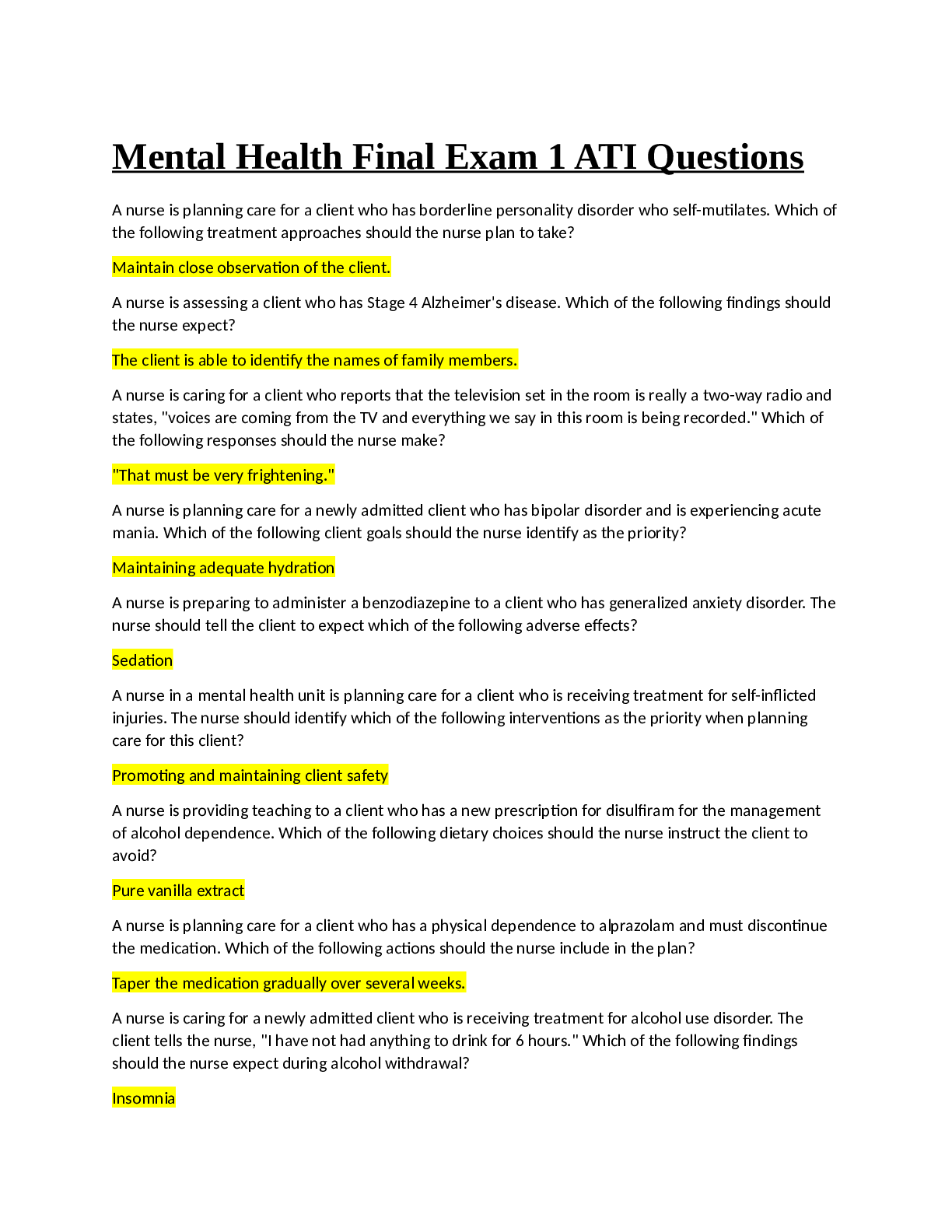
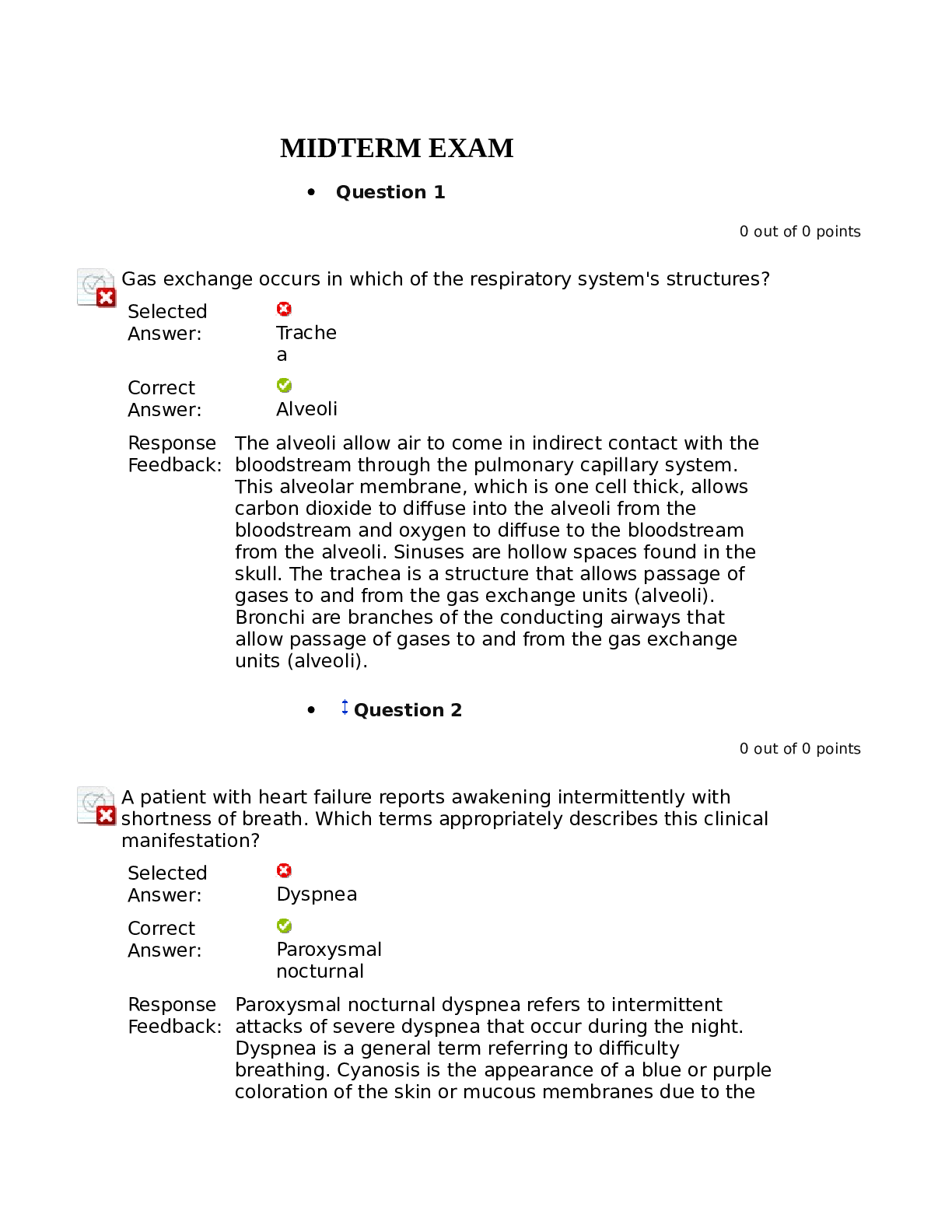
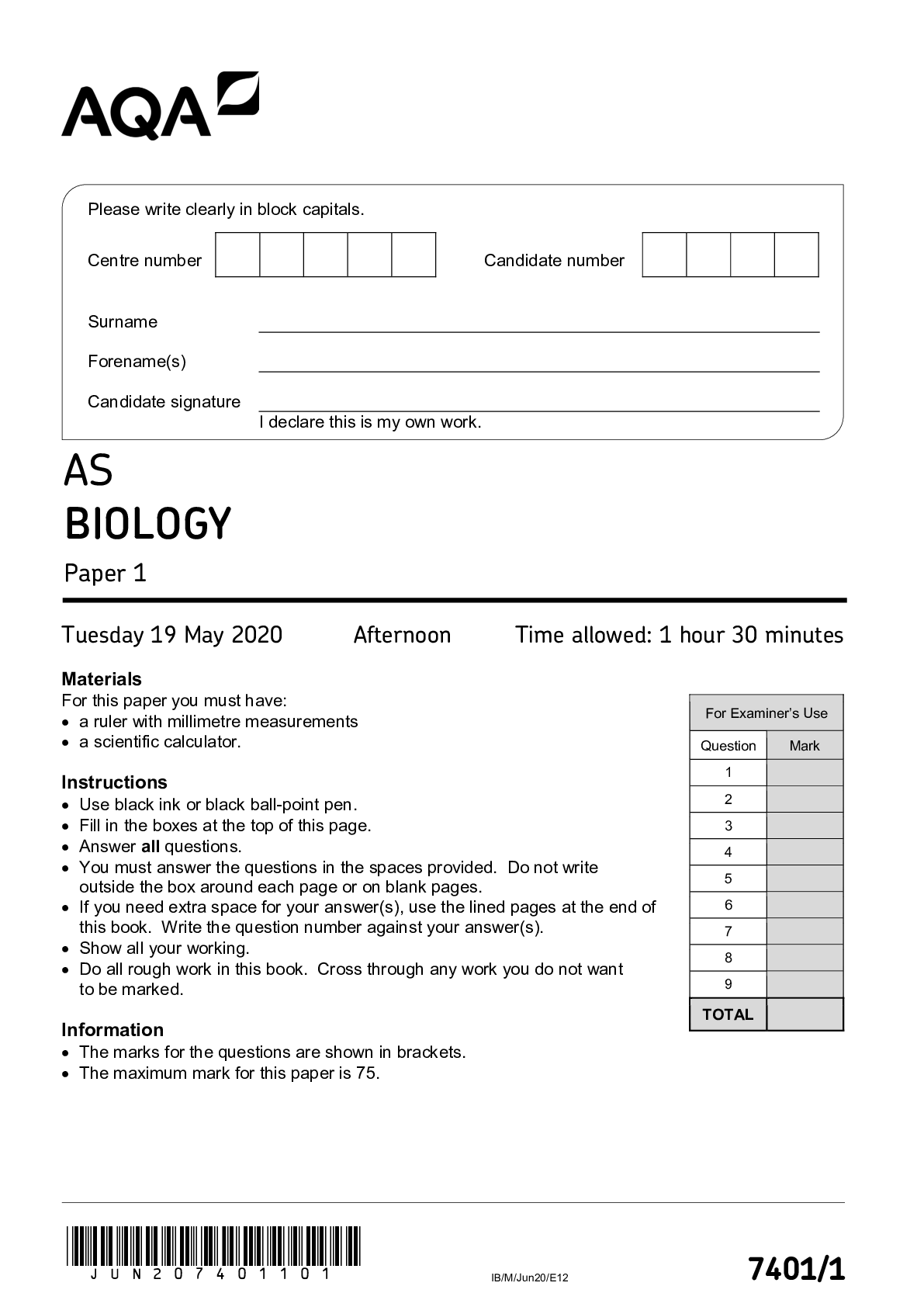
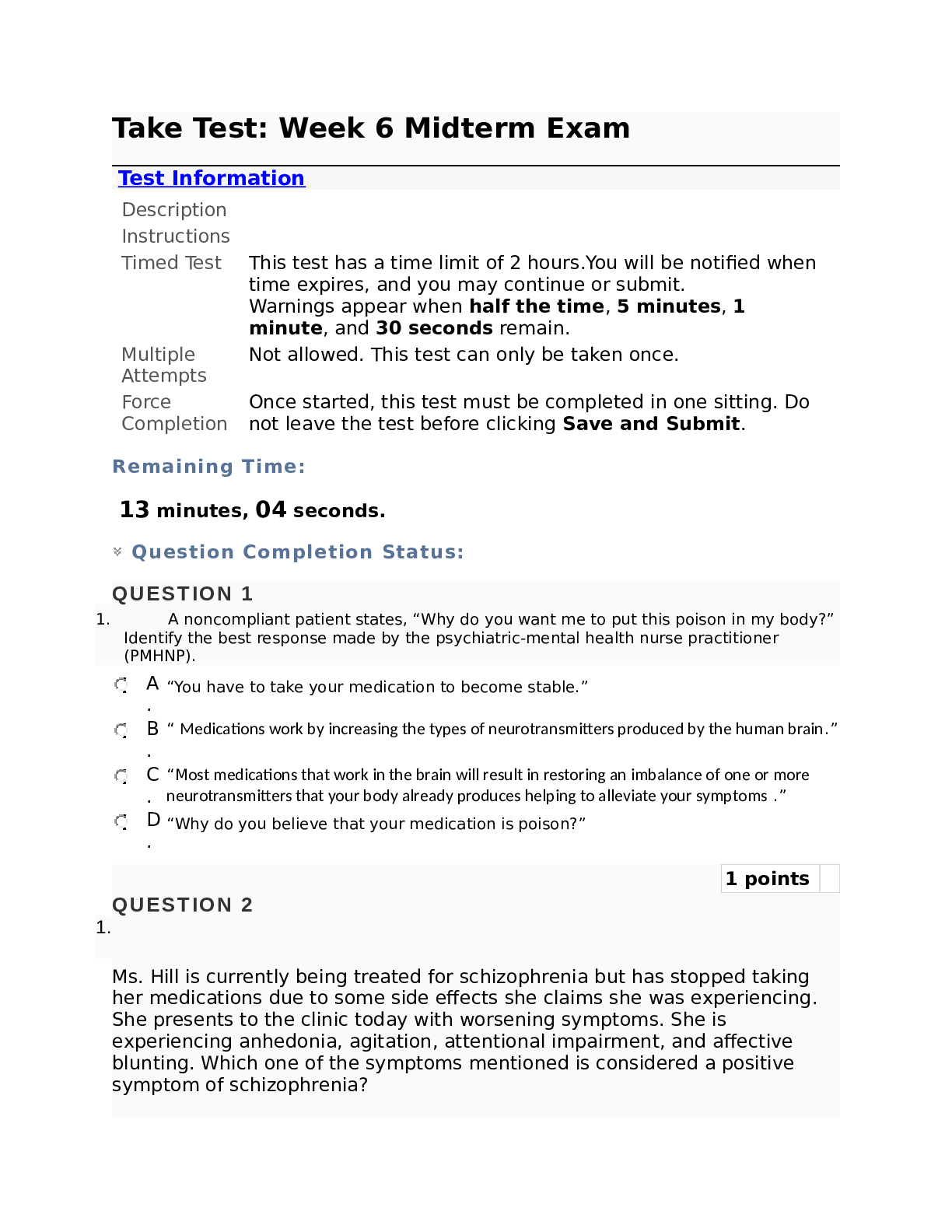




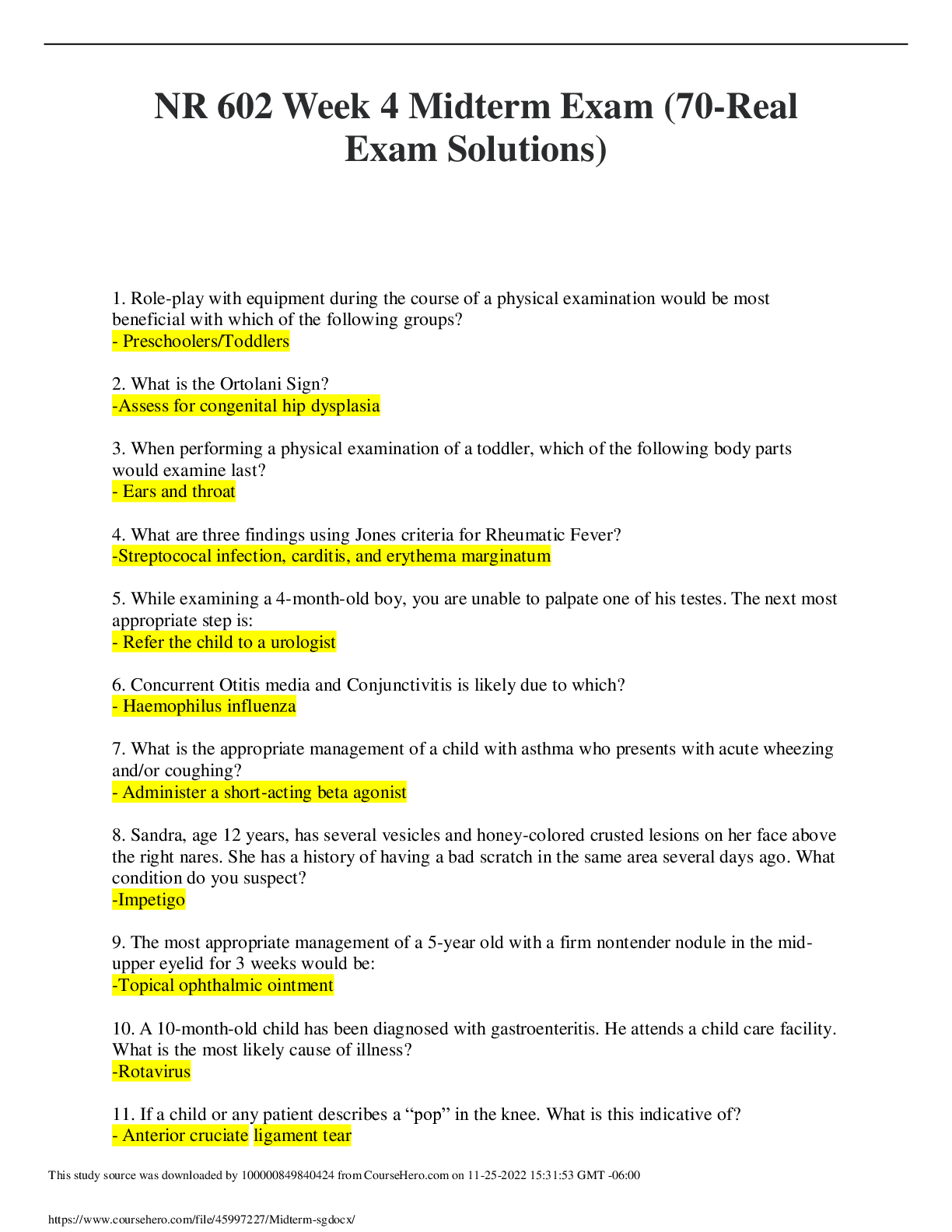

.png)


